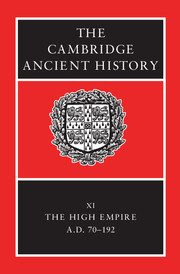Book contents
- Frontmatter
- PART I NARRATIVE
- PART II GOVERNMENT AND CIVIL ADMINISTRATION
- PART III THE EMPIRE
- PART IV ROME, ITALY AND THE PROVINCES
- PART Va ECONOMY AND SOCIETY
- 23 The land
- 24 Trade
- 25 Industry and technology
- 26 Commerce and finance
- 27 Demography
- 28 Status and patronage
- 29 Family and household
- PART Vb ART AND CULTURE
- Chronological Table
- BIBLIOGRAPHY
- Index
- 1 The Roman world in the time of Marcus Aurelius
- 7 The Danube provinces
- References
25 - Industry and technology
from PART Va - ECONOMY AND SOCIETY
Published online by Cambridge University Press: 28 March 2008
- Frontmatter
- PART I NARRATIVE
- PART II GOVERNMENT AND CIVIL ADMINISTRATION
- PART III THE EMPIRE
- PART IV ROME, ITALY AND THE PROVINCES
- PART Va ECONOMY AND SOCIETY
- 23 The land
- 24 Trade
- 25 Industry and technology
- 26 Commerce and finance
- 27 Demography
- 28 Status and patronage
- 29 Family and household
- PART Vb ART AND CULTURE
- Chronological Table
- BIBLIOGRAPHY
- Index
- 1 The Roman world in the time of Marcus Aurelius
- 7 The Danube provinces
- References
Summary
INDUSTRY
Any study of Roman industry is confronted by a basic problem, highlighted by Hopkins and Duncan-Jones: ‘In the ancient economy, agriculture was clearly pre-eminent; most adults in the Roman world worked in the fields; most wealth was based on landownership’; ‘Almost everywhere a large part of the population was engaged in agriculture at a relatively low level, while industry depended on a backward technology and was rarely organised in large units.’ In contrast, the products of Roman industry abound in museums and on archaeological sites. Vast quantities of fine stone were employed in imperial, civic and religious architecture and statuary; the army required iron, copper and lead for the manufacture of its comprehensive range of weapons and equipment; and most ordinary households used pottery which was produced on a very large scale, and traded over long distances. The overall level of production must have been determined by demand, and opinions are divided about the extent to which it was articulated by market-centred transactions involving coinage, or dominated by bulk-purchasing by the state and army. The answer is probably a combination of the two, stimulated by an aggregate demand from millions of peasants and town-dwellers incorporated into a single empire with comparatively good communications.
Literary sources for the study of Roman industry are extensive, but almost entirely superficial. Strabo and Pliny the Elder both provided comprehensive catalogues of the resources and products of many regions of the empire. These texts, combined with historical interpretations and supplemented by epigraphic sources, formed the basis of extensive sections of Tenney Frank's Economic Survey of Ancient Rome, Rostovtzeff's Social and Economic History of the Roman Empire and Charlesworth's Trade Routes and Commerce of the Roman Empire; all three were written before archaeology began to make a substantial contribution to our knowledge.
Keywords
- Type
- Chapter
- Information
- The Cambridge Ancient History , pp. 741 - 768Publisher: Cambridge University PressPrint publication year: 2000
References
- 2
- Cited by

